
| << The castle is fully assembled! 2020-12-03 | Samurai Castle is available NOW! >> 2020-12-13 |
It took only 3 days to paint the castle, inside and out, but those were looooong days!
Cheap spray cans can be used to do the bulk of the work, and then I used cheap acrylics to drybrush and add details, and then finally some home-made washes to finish up. Here are the major stages...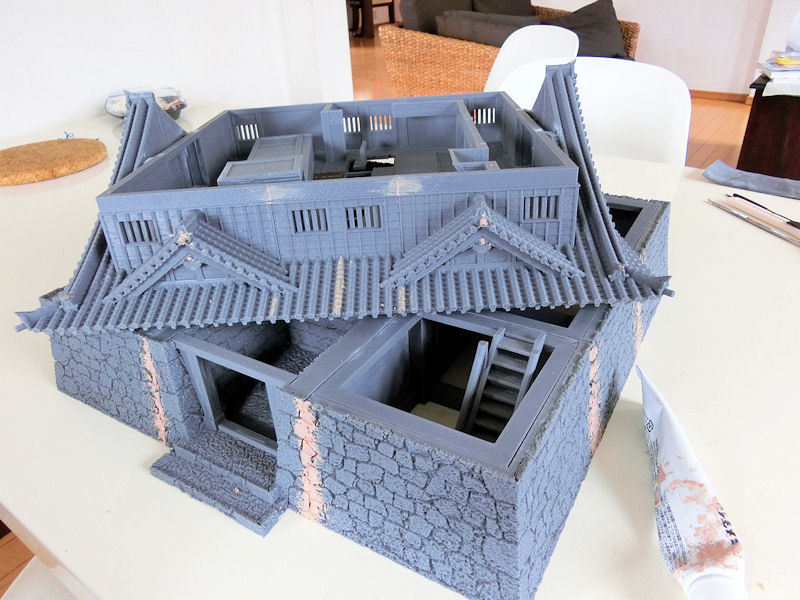
£ Before painting the model, it's probably a good idea to check it for gaps between sections and fill those in if necessary. Thankfully, gaps on the walls and roof sections are mostly hidden, so the only big gaps were in the base. I used wood putty filler smeared on thickly, and smoothed over with a (very dirty) finger!

£ First stage of the painting process was to spray the underside of each level with matt white. Honestly, this will save you SO much time! I did two coats of spray to make it a clean white cover.
Once that was dry, I used masking tape to close the holes for the stairs, and then flipped them over and sprayed each layer with a light brown matt. This is good for the exterior wood, and also works well for the interior beams.

£ So now the bottom of each section was white, and the top of each section was brown. Only one more major colour remained - grey for the roof tiles. After taping over the interior of each section (with sheets of paper) and roughly masking the exterior wood, I sprayed each section with a matt charcoal grey.
Japanese castles, by the way, can also be seen with green roof tiles (see Osaka castle) and red roof tiles (see Shuri castle in Okinawa), but the majority seem to be grey/black. So have a look around before choosing your colours!
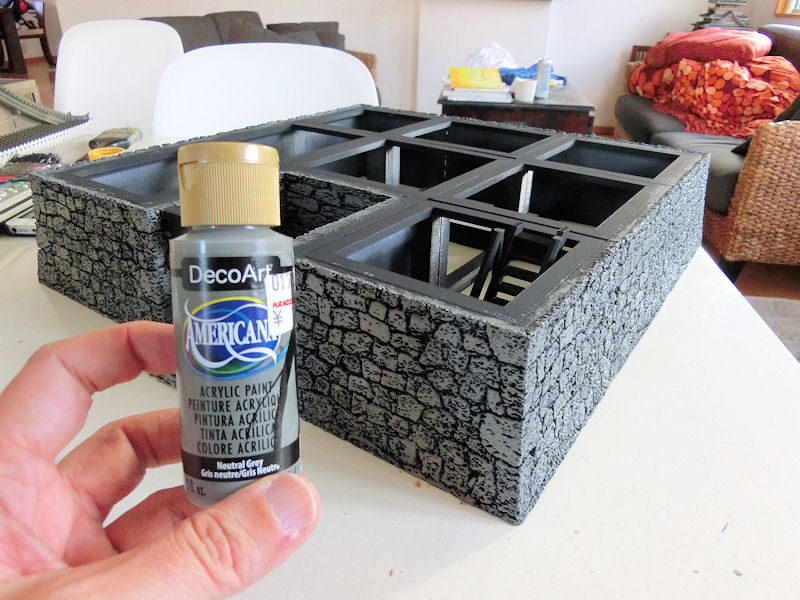
£ The base section was sprayed in matt black, and roughly painted over with a mid-grey (Neutral Grey by Americana Deco-Art).
The base was completed with a black wash, then a light beige drybrush followed by a light grey drybrush, and then finally some rocks were washed with browns and reds to make it more interesting, and then green wash at the bottom of each wall.
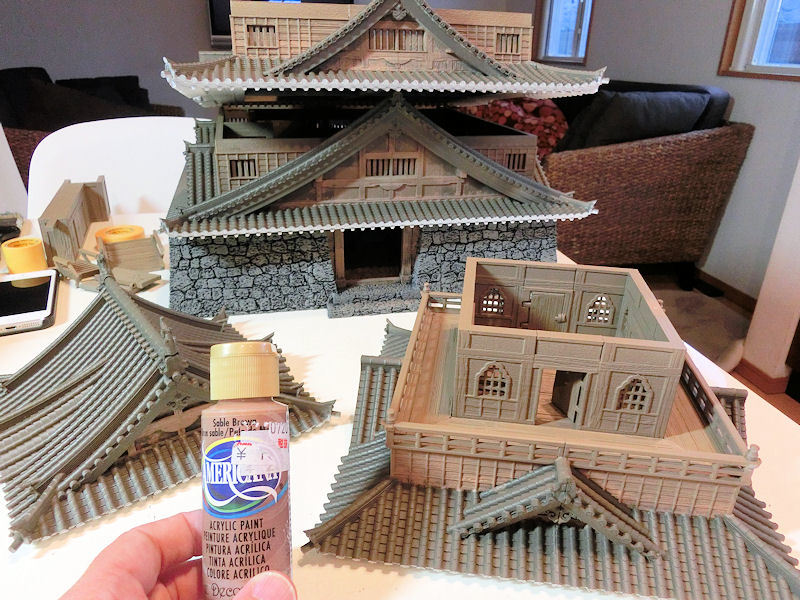
£ Since the spray cans (and my masking tape) were done pretty roughly, I needed to tidy up a few places. I used this Sable Brown as a pretty close match to my spray colour, to neaten up the edges of the wood next to the rooftiles, and paint in the wood beams at the gable ends and the gateway.
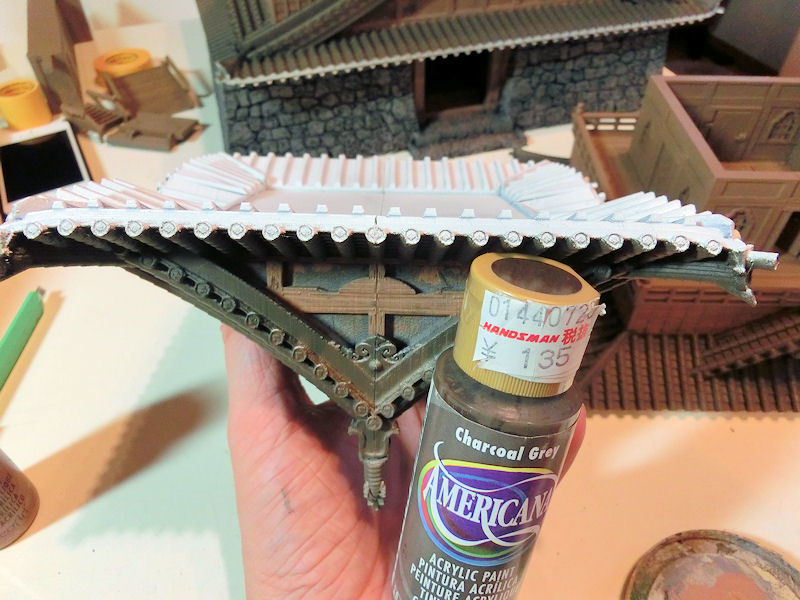
£ In this photo you can see that the edges of this roof section (shown upside down) have white circles at the ends of each row of tiles, but these obviously need to be grey. Again, I found a very close match to my spray colour, and painted those in with a 1cm wide brush in Charcoal Grey.
With that, the basic colours of my castle were done!
On to the washes......
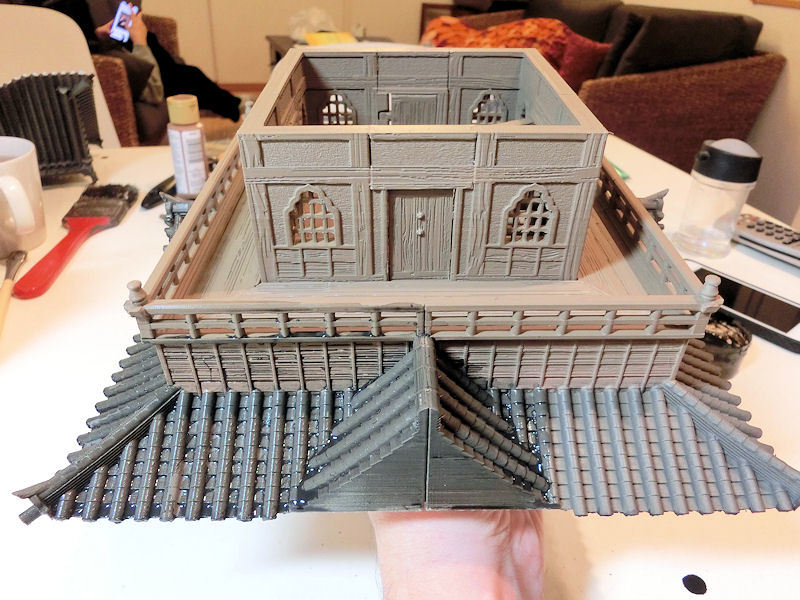
£ This castle is BIG. Using expensive paints and washes can get expensive! So I really, really recommend mixing your own washes for this model, to save yourself some money. This is actually pretty easy, and you'll only need a bottle of acrylic ink (black, brown etc), a matte medium (only a few drops), a drop of dish washing liquid to help it flow, and some water.
There's a guide here to making your own washes, on our club site:
https://www.kitaqgamers.com/page.php?ID=201&La=E
Anyway, I made myself a pot of black wash, and painted over the roof tile sections with a large brush. On the photo you can see that I also tried it on the wood section (on the left), but decided to revisit that later with a stronger wash to produce a darker wood.
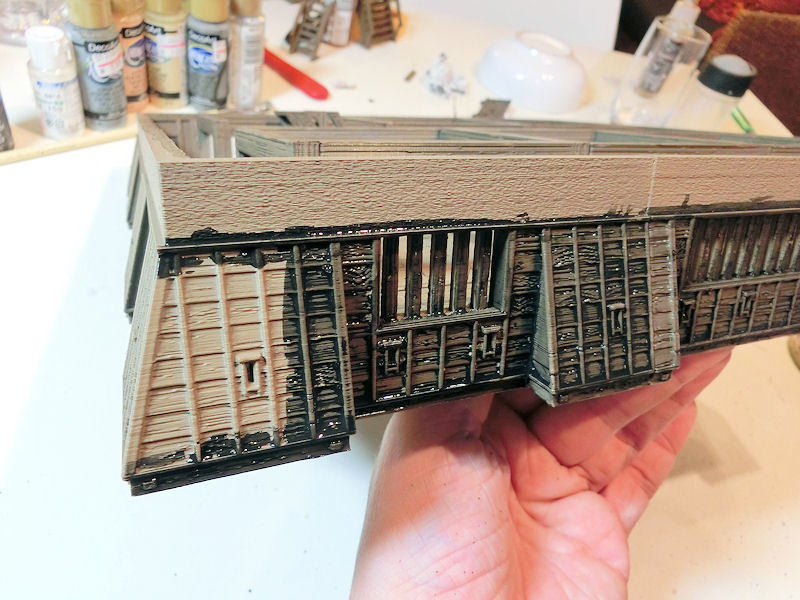
£ Japanese castles panelled in wood tend to be very dark (but obviously it's YOUR castle, so you can choose!), and I tried to duplicate this by mixing much more black ink into the wash. This produced the very dark wash as shown above - which worked very well to show the woodgrain.
After that was dry, I painted the top of each exterior wall white (2 coats), and also filled in the gable end walls in white between the wood beams.... but I forgot to take a photo! It was quite tedious, to be honest, especially knowing you have to do it twice!
A final touch was to lightly drybrush the roof sections in a mid-grey, with a 2" brush! This picks out the ridges and bumps on the roof tiles beautifully. The exterior was now finished!
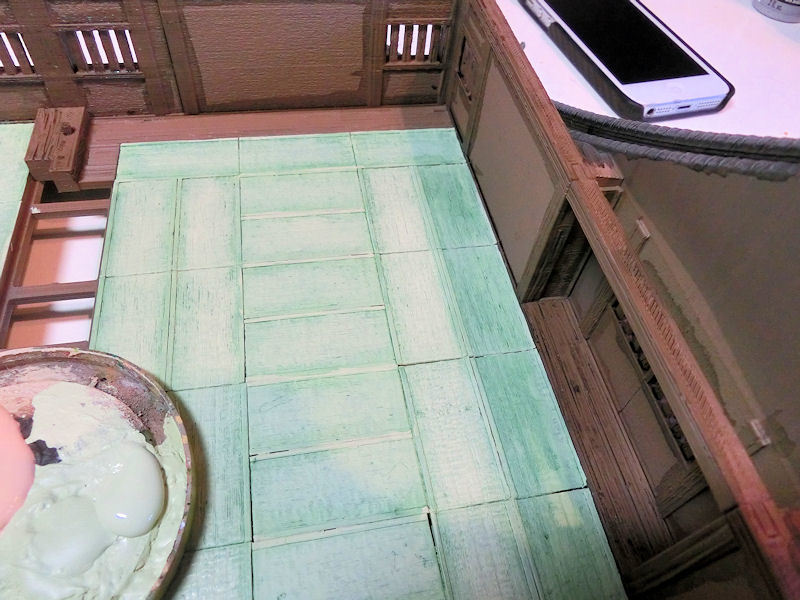
£ Most Japanese tatami mats tend to be light straw-coloured when they are new, and darker yellows when they are older mats. However, castles would usually have super fresh tatami mats, and you can choose to paint these this light mint-green colour. I thought that would be a nice contrast with the interior walls, which I planned to do in a pale sand colour.
I used Soft Sage by Americana to paint all the mats in the castle, but found that they need a little darkening to bring out the texture of the mats. For that, I diluted a green wash (by Games Workshop) with plenty of water, and brushed that quickly over all the mats. This made the texture a little splotchy (you can see this in the row of mats on the right), so I went back over the centre of each mat with a little Soft Sage again, leaving the darker green washed areas to the sides.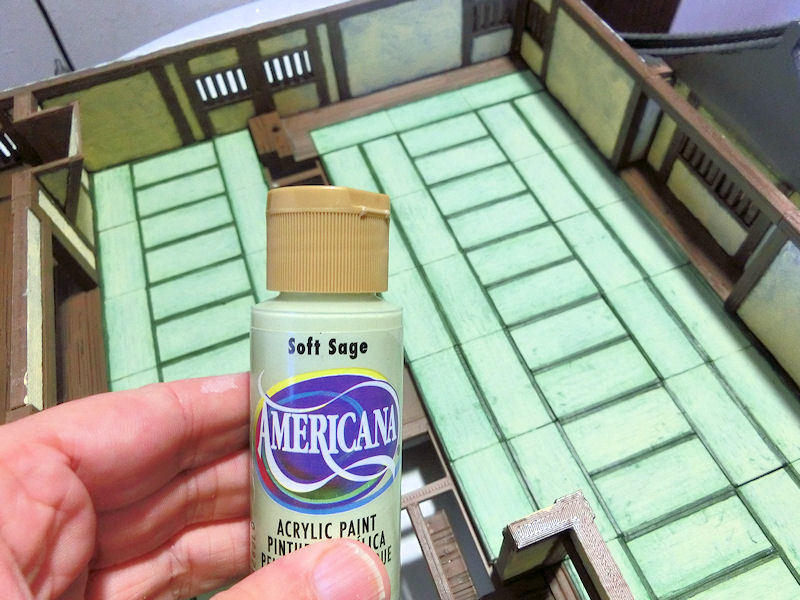
£ The last step for the tatami mats is to paint the fabric strips on each side. I will admit this was painfully tedious! I chose green, but other common colours would be blue, navy blue, grey or black. If you want to go nuts with gold flecks in the fabric, be my guest!
I hand painted these, and it took ages! Looking back, I realise that using a paint pen would have saved lots of time. Oh well!
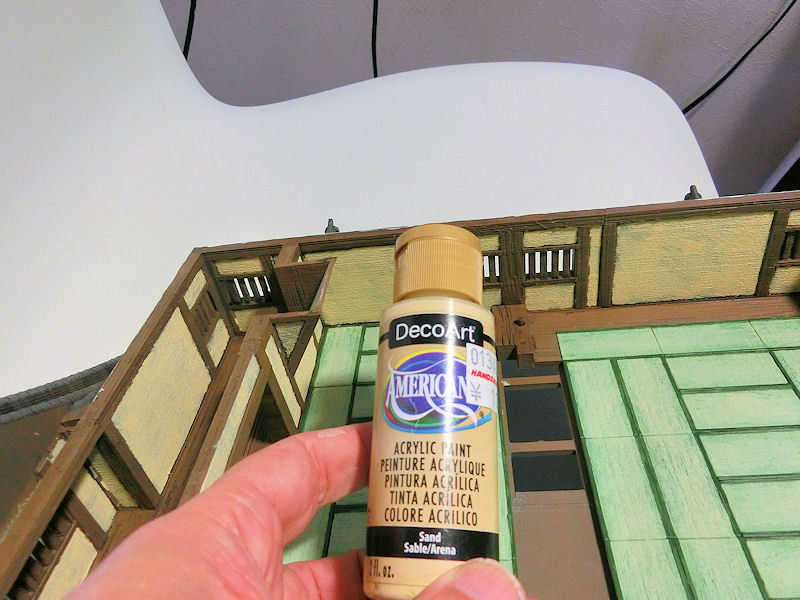
£ For the interior walls, I used this sand colour applied with a 1cm brush (with a very straight edge!). One day I might go back and give these wall panels a sepia wash for some depth, but I ran out of time a little!
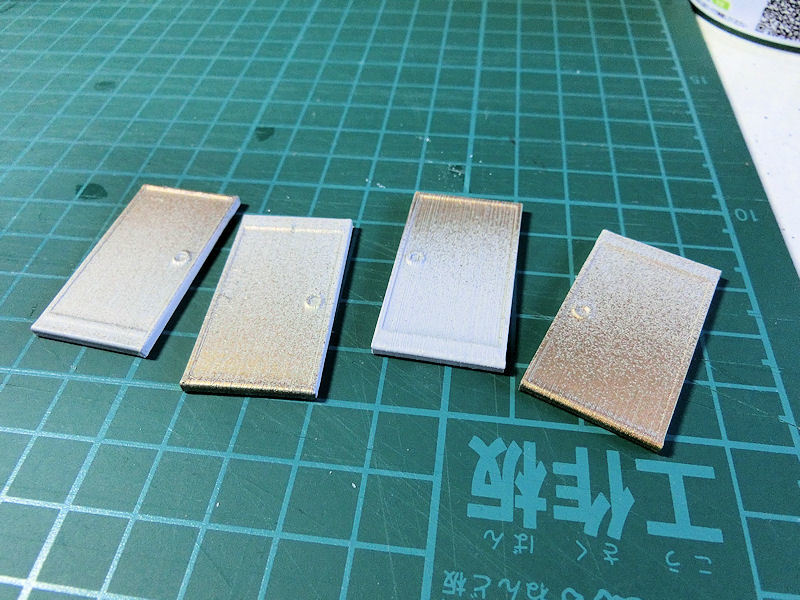
£ This castle needs loads of sliding doors, and I needed to speed through this step. So I spray undercoated both sides in a cream colour, and then lined up all the doors in rows.... and zoomed along each row quickly with a gold spray can! This gave the effect of gold flecks, which is a common design on Japanese doors.
Again, do some image searches for sliding doors. Some have thick stripes across the middle, some are more plain, and some are extremely ornate. I chose "quick and easy"!!

£ Trying to hand paint the edges of those doors would be very time consuming, and I don't have the patience or the skill to keep my hand steady! So I cheated and used a paint pen. Well, two, in fact.
I used a paint pen with a thicker flat 5mm tip to do the edges of each door, and then a thinner round tip to colour the door 'handles'. You can obviously choose whatever colour you need (or wood), but I chose black - probably the most common colour for sliding doors.

£ The last step to complete the castle was to add some "bling" to the throne room. I had painted all the other doors in the castle with my quick and easy two-tone spray method, so for the 9 doors in the throne room I wanted to add a very ornamental design.
You could try hand-painting this with lots of gold if you like, but I didn't have the luxury of time - so I cheated and photoshopped this design together to print out. Then I simply cut each panel to size, pushed my finger over the door handle to get an imprint, cut out the circle over each door handle, and glued it into place.
Just in case you'd like to use it, you can download this design here:
So that's it! The castle is finished! This weekend we'll be seeing those finished photos, and you can see for yourself how the whole thing looks.....
| << The castle is fully assembled! 2020-12-03 | Samurai Castle is available NOW! >> 2020-12-13 |
